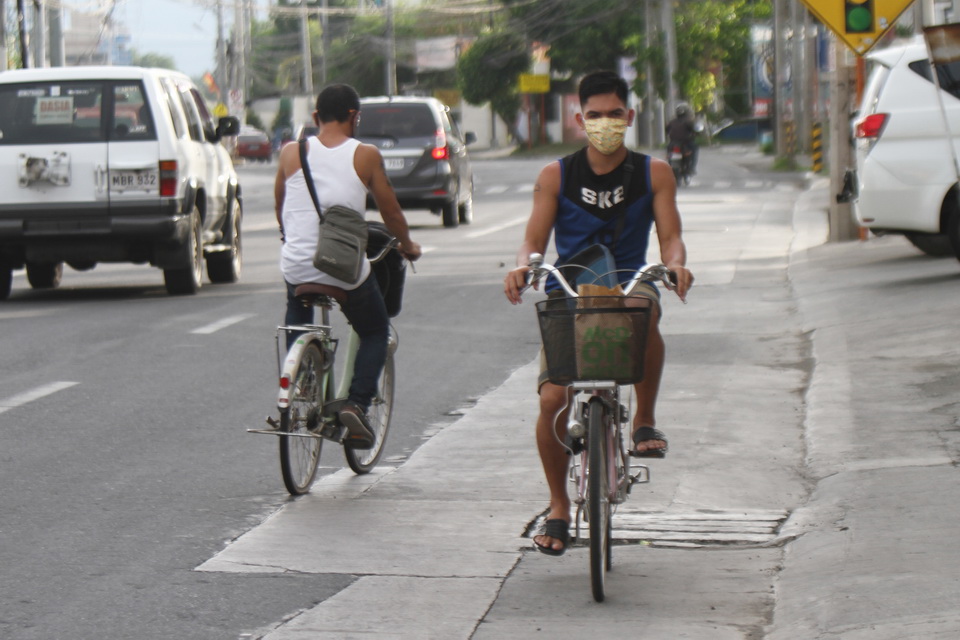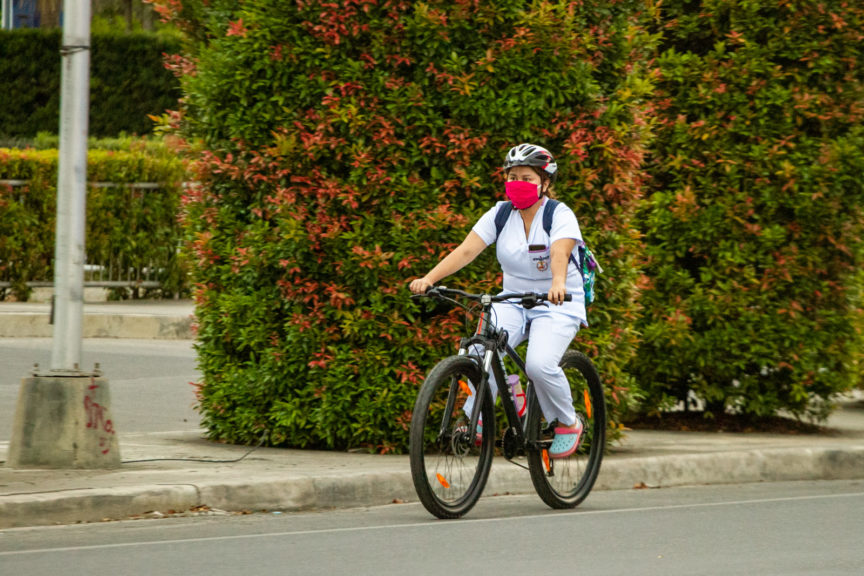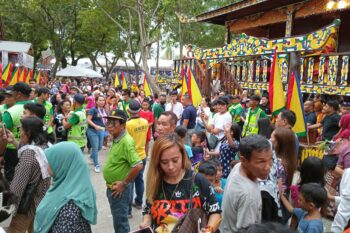DAVAO CITY (MindaNews / 25 May) — Writer Jesse Pizarro Boga rides his bicycle to work and finds the sight of more cyclists on the road invigorating.
He said bicycles could give commuters more options for transportation as the cramped and outdated public utility jeepneys (PUJs) have become increasingly uncomfortable and unsafe, with many drivers failing to adhere to the speed limits and traffic rules.
“The bicycles are a force to reckon with in the fight against COVID-19 because it empowers each of us to use resources we already have for movement: our own bodies and maybe a little sunblock! They celebrate traffic responsibility and right on an individual level; and forge friendly communities,” he explained.
 In the “new normal,” more people will bike to work but are the streets of Davao CIty safe for bikers? Mindanews Photo
In the “new normal,” more people will bike to work but are the streets of Davao CIty safe for bikers? Mindanews Photo
Boga said bicycles are undeniably more sustainable compared to other transport modes, and could even last for years with proper maintenance.
If the bike lanes could not be done given the current limitation on the road structures, Boga hopes the city could at least make the roads less hostile for cyclists by installing markers and signages to encourage motorists to share the road.
“I would also love for the government to give tax incentives to big establishments that provide bike friendly facilities like racks, changing rooms and air pumps. It’s the best we can do for now,” he said.
The Sustainable Davao Movement (SDM), a network of individuals, multi-sectoral organizations and institutions advocating for a greener and more sustainable Davao City, wrote Mayor Sara Duterte on May 18 to remind her of the 10-year old “Bicycle Ordinance” which contains, among others, a provision on bike lanes. (See other story)
Environmentalists, cyclists, call on Davao City gov’t to implement 2010 Bicycle Ordinance
Bike to help flatten the curve
Environmental planner Lemuel Manalo, IDIS research specialist, said his group has been advocating for the full implementation of the ordinance as the existing city and national roads are quite challenging as a consequence of “car-centric” flaws in transport planning, making them unsafe for cyclists.
After passage of the ordinance a decade ago, Manalo said civil society organizations have been pushing for its full implementation through advocacy such as the Flight of the Eagles, National Bicycle Day, among others, which show that a lot of bikers are clamoring for bike lanes and racks.
Manalo said the use micro-mobility by the commuters, like bicycles, scooters, and skateboards would lessen the demand for PUJs, particularly during peak hours, since a one-seat apart policy to maintain physical distancing would reduce the holding capacity of PUJs.
He said using “micro-mobiles” could give the seats on PUJs to the ones who need them more such as the handicapped, elderly, pregnant women, passengers with infants, and frontline health workers.
He said the bicycles could complement the inefficient mass public transport, which could no longer keep up with the demand of the commuters.
In this time of crisis, Manalo said bicycles could play an important role in reducing the risk of contagion in public transport, anticipating more Dabawenyos to shift to biking to help flatten the curve.
Manalo recommended delineating the lanes for at least 1.8-meter wide for both sides using temporal traffic cones along the roads that are mainly used by the cyclists; biking in groups to encourage more cyclists; and enforcing the bicycle hours and days.
“What we, cyclists, are appealing as of now in this pandemic and crisis are temporary bike lanes and not necessarily full infrastructure development; temporary bike lanes can be delineated by using traffic cones and traffic barriers,” he said.
Safety measures
He added since frontliners and other workers, many of them inexperienced cyclists, have started riding bicycles under the “new normal,” it is important to establish temporary bike lanes to keep them from harm’s way.
“Most of them are not experienced road cyclists, and the only reason why they choose to ride bicycles is because there is a crisis and the public transport is limited. They need this additional safety measure. While I was riding my bike, I saw a frontliner from SPMC (Southern Philippines Medical Center) biking at the opposite lane, which is very dangerous. It is because cyclists have no designated lanes to follow, many of them in outer lanes while others in the middle,” Manalo said.
 An employee of the Southern Philippines Medical Center, the designated Covid-19 hospital for Davao City, rides a bicycle on 15 April 2020. Public transportation has been stopped except for taxis and tricycles under the enhanced community quarantine for Covid-19 of Davao City. MindaNews photo by MANMAN DEJETO
An employee of the Southern Philippines Medical Center, the designated Covid-19 hospital for Davao City, rides a bicycle on 15 April 2020. Public transportation has been stopped except for taxis and tricycles under the enhanced community quarantine for Covid-19 of Davao City. MindaNews photo by MANMAN DEJETO
Manalo said the local government could adopt transport-planning strategies such as “road dieting and road-use changes” once the pandemic is over to make the transport system more efficient.
“Road dieting is reducing vehicle lane measurements, example, from 5 meters to 3.6 meters, to add bicycle lane space while the road-use change is changing the use of road, for example, parallel parking lane or the slow lane to be intended for bicycle lanes or pedestrian walkways,” Manalo added.
He said he had seen a few improvements in the road infrastructure planning. Chief among them are the provisions on the bicycle lanes in the P19.8 billion Davao City Coastal Bypass Road Project of the Department of Public Works and Highways.
The multi-billion project is composed of four segments: the segment A will run from Bago Aplaya to Matina Aplaya; segment B from Times Beach, Ecoland to Matina Aplaya to Roxas Avenue; segment C from Roxas Avenue to Sta. Ana Avenue; and segment D is toward R. Castillo, Agdao District.
Bikes as priority mode of transport
Monica Ayala, current administrator of Cycle for Life, called on the local government to revisit the Bicycle Ordinance.
Considering the road scenes on Day 1 of the General Community Quarantine on May 16, Ayala appealed to the local government to observe the truck ban hours, prioritize bicycles as mode of transport, and regulate the use of cars, in that there should be one passenger who is a child, elderly, pregnant, or person with disability “to provide an immediate solution to our road conditions”
“As of now, it (PUJ) is a livelihood more than a service. That’s why, some drivers are still on ‘race’ mode to pick up more passengers. Also, due to the requirement to put physical distancing barriers on all PUVs before they are given special permits to operate, the potential to earn an income is also less, as practically only 50% capacity of passenger load is allowed to practice social distancing measures, thus increasing the anxieties of this sector trying to make ends meet and to feed their families,” she said.
She said this would trigger a “fight and flight response of drivers that cyclists and pedestrians can get caught in the rush, who may end up dead, injured, handicapped and traumatized for life if they survive.”
She said a “number coding scheme” for PUVs might be considered to regulate their numbers on the roads.
“These times of COVID are making it very challenging by testing the models we are once used to if they are still workable under the extreme circumstances affecting general public health. The COVID is also bringing out more considerations for the basic essentials for human survival, care for the environment, and the quality of life of people,” she said. (Antonio L. Colina IV / MindaNews)
